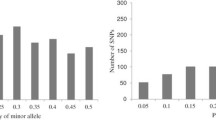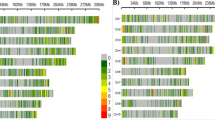Abstract
A comparative characterization of 10 field populations of the maize (Zea mays var. indurata) landrace “Nostrano di Storo” was carried out using different types of PCR-based markers. The inbred line B73 and three synthetics (VA143, VA154 and VA157) selected from as many landraces were also used. Genetic diversity and relatedness were evaluated over 84 SSR and 53 I-SSR marker alleles using a total of 253 individual DNAs. Up to 23 alleles per SSR locus were scored while the average effective number of alleles per population was 6.99. Nei's total genetic diversity as assessed with SSR markers was HT = 0.851 while the average diversity within populations was HS = 0.795. The overall Wright's fixation index FST was as low as 0.066. Thus, more than 93% of the total variation was within population. Unique alleles over all SSR loci were found for six populations. An average of 17.7 marker alleles per I-SSR primer were scored with an effective number of marker alleles per locus of 1.34. The Shannon's diversity information index over all populations and I-SSR loci was 0.332, varying from 0.286 to 0.391. The extent of differentiation between populations was as low as GST = 0.091. Dice's genetic similarity matrices were estimated for both SSR and I-SSR markers. The mean genetic similarity coefficients within and between populations were respectively 0.269 and 0.217, for SSR markers, and 0.591 and 0.564, for I-SSR markers. UPGMA dendrograms displayed all field populations but one clustered into a distinct group, in which the synthetic VA154, selected from the “Marano Vicentino” landrace, was also included. One field population and the other two synthetics were clustered separately as well B73. The matrix correlation assayed by the Mantel's correspondence test was as high as 0.908. Findings suggest that, although a high variability can be found among plants, most plant genotypes belong to the same landrace called “Nostrano di Storo”. Although gene flow from commercial hybrids might have occurred, the large number of polymorphisms and the presence of both unique alleles and alleles unshared with B73 and synthetics are the main factors underlying the value of this flint maize landrace as a source of genetic variation and peculiar germplasm traits. Because of its exclusive utilization for human consumption, such a molecular marker characterization will be a key step for obtaining the IGP mark and so promote the in situ conservation and protection of the landrace “Nostrano di Storo”.
Similar content being viewed by others
References
Azar C., Mather D.E. and Hamilton R.I. 1997. Maize landraces of the St. Lawrence Great Lakes region of North America. Euphytica 98: 41–48.
Barcaccia G., Lucchin M. and Parrini P. 1999. Genetic diversity and relatedness in an Italian landrace of flint maize as assessed by PCR-based molecular markers Atti XLIII Convegno Annuale Societa Italiana Genetica Agraria, Molveno, TN, Italy, September 22-25, 1999., pp. 94–95.
Barcaccia G., Albertini E. and Veronesi F. 2000. Inter-microsatellite DNA markers in the Medicago sativa complex. In: Provorov N.A., Tikhnovich I. and Veronesi F. (eds), New approaches and techniques in breeding sustainable fodder crops and amenity grasses. Proc. of the 22 EUCARPIA Fodder Crops and Amenity Grasses Section Meeting, October 17-21, 1999, St. Petersburg, Russia., pp. 185–190.
Bertolini M., Bianchi A., Lupotto E., Salamini F., Verderio A. and Motto M. 1998. Maize. In: Scarascia Mugnozza G.T. and Pagnotta M.A. (eds), Italian Contribution to Plant Genetics and Breeding. Tipolit. Quatrini A. & F. Publisher, Viterbo, Italy, pp. 209–229.
Bonciarelli F. 1961. Studio agronomico comparato delle popolazioni Umbre di mais (A comparative study of the maize population of Umbria, Italy, with English summary). Maydica 6: 35–61.
Bosch L., Casanas F., Sanchez E. and Nuez F. 1997.Variability of characterizamaize landraces from Northwest Spain. Plant Genetic Resources Newslet. 112: 90–92.
Brandolini A., Lorenzoni C. and Vandoni G.C. 1967. I mais Italiani (The Italian maize). Enciclopedia Agraria, REDA M: 8–12.
Brandolini A. 1970. Maize. In: Frankel O.H. and Bennett E. (eds), Genetic Resources in Plants. Their Exploration and Conserva-tion. Blackwell Scientific Publications, pp. 273–309.
Bretting P.K., Goodman M.M. and Stuber C.W. 1987. Isozyme variation in Guatemalan races of maize (Zea mays L. ssp. mays). Am. J. Botany 74: 666–667.
Brush S.B. 1995. In situ conservation of landraces in centers of crop diversity. Crop Sci. 35: 346–354.
Brush S.B. 1999. The issues of in situ conservation of crop genetic resources. In: Brush S.B. (ed.), Genes in the Field. On-farm Conservation of Crop Diversity. Lewis Publishers, Boca Raton, FL, USA Copublished by Intl. Plant Genetic Resources Institute, Rome, Italy; Intl. Development Research Centre, Ottawa, Canada., pp. 3–26.
Camussi A. 1979. Numerical taxonomy of Italian populations of maize based on quantitative traits. Maydica 24: 161–174.
Camussi A., Jellum M.D. and Ottaviano E. 1980. Numerical taxonomy of Italian maize populations:. fatty acid composition and morphological traits. Maydica 25: 149–165.
Dellaporta S.L., Wood J. and Hisks J.B. 1983. A plant DNA minipreparation. Version II. Plant Mol. Biol. Rep. 4: 19–21.
Dice L.R. 1945. Measures of the amount of ecological association between species. Ecology 26: 297–302.
Frankel O.H., Brown H.D. and Burdon J. 1995. The Conservation of Plant Biodiversity. Cambridge University Press, Cambridge, UK.
Goodman M.M. and Stuber C.W. 1983. Races of maize. VI. Isohelpful zyme variation among races of maize in Bolivia. Maydica 28: 169–187.
Goodman M.M. 1994. Maize. In: Simmonds N.W. (ed.), Evolution of Crop Plants. Longman Group, Ltd., Essex, UK.
Gregorius H.R. 1987. The relationship between the concepts of genetic diversity and differentiation. Theor. Appl. Genet. 74: 397–401.
Hallauer A.R., Russell W.A. and Lamkey K.R. 1998. Corn breeding. In: Sprague G.F. and Dudley J.W. (eds), Corn and Corn Improvement. Am. Soc. Agron., Inc., Madison, Wisconsin, USA, pp. 463–564.
Kantety R.V., Xiaping Zeng, Bennetzen J.L. and Zehr B.E. 1995. Assessment of genetic diversity in dent and popocorn (Zea mays L.) inbred lines using inter-simple sequence repeat (ISSR) amplification. Mol. Breed. 1: 365–373.
Kimura M. and Crow J.F. 1964. The number of alleles that can be maintained in a finite population. Genetics 49: 725–738.
Lanza F. 1961. Un secolo di maiscoltura Italiana: 1861-1960 (One hundred years of corn growing in Italy: 1861-1960, with English summary). Maydica 6: 136–145.
Levene H. 1949. On a matching problem in genetics. Ann. Math. Stat. 20: 91–92.
Lewis P.O. and Zaykin D. 1999. GDA Version d12. University of New Mexico, Albuquerque, NM.
Lewontin R.C. 1972. The Genetic Basis of Evolutionary Change. Columbia Univ. Press.
Louette D. and Smale M. 2000. Farmer's seed selection practices and traditional maize varieties in Cuzalapa, Mexico. Euphytica 113: 25–41.
Manly B.F.J. 1985. The Statistics of Natural Selection on Animal Populations. Chapman and Hall, London, UK.
Mantel N.A. 1967. The detection of disease clustering and a generalized regression approach. Cancer Res. 27: 209–220.
McDermott J.M. and McDonald B.A. 1993. Gene flow in plant pathosystems. Annu. Rev. Phytopathol. 31: 353–373.
Melchinger A.E., Messmer M.M., Lee M., Woodman W.L. and Lamkey K.R. 1991. Diversity and relationships among U.S. maize inbreds revealed by restriction fragment length polymor-phisms. Crop Sci. 31: 669–678.
Morgante M. and Olivieri A.M. 1993. PCR-amplified microsatellites as markers in plant gnetics. The Plant J. 3: 175–182.
Nei M. 1973. Analysis of gene diversity in subdivided populations. Proc. Natl. Acad. Sci. USA 70: 3321–3323.
Nei M. 1978. Estimation of average heterozigosity and genetic distance from a small number of individuals. Genetics 89: 583–590.
Nei M. and Li W.H. 1979. Mathematical model for studying genetic variation in terms of restriction endonucleases. Proc. Natl. Acad. Sci. USA 76: 5269–5273.
Pejic I., Ajmone-Marsan P., Morgante M., Kozumplick V., Castig-lioni P., Taramino G. et al. 1998. Comparative analysis of genetic similarity among maize inbred lines detected by RFLPs, RAPDs, SSRs, and AFLPs. Theor. Appl. Genet. 97: 1248–1255.
Pfluger L.A. and Schlatter A.R. 1996. Isozyme variation in some races of maize from Argentina. Genet. Res. Crop Evol. 43: 357–362.
Powell W., Morgante M., Andre C., Hanafey M., Vogel J., Tingey G. et al. 1996. The comparison of RFLP, RAPD, AFLP and SSR (microsatellite) markers for germplasm analysis. Mol. Breed. 2: 225–238.
Revilla P., Soengas P., Malvar R.A., Cartea M.E. and Ordas A. 1998. Isozyme variation and historical relationships among the maize races of Spain. Maydica 43: 175–182.
Rohlf F.J. 1993. NTSYS-pc Numerical Taxonomy and Multivariate Analysis System. State University of New York, Stony Brook, NY, Version 1.8.
Sambrook J., Fritsch E.F. and Maniatis T. 1989. Molecular Cloning, a Laboratory Manual. Cold Spring Harbor Laboratory Press, Cold Spring Harbor, NY, 2nd ed.
Sanau J., Gouesnard B. and Charrier A. 1997. Isozyme variability in West African maize cultivars (Zea mays L.). Maydica 42: 1–11.
Senior M.L., Murphy J.P., Goodman M.M. and Stuber C.W. 1998. Utility of SSRs for determining genetic similarities and relation-ships in maize using an agarose gel system. Crop Sci. 38: 1088–1098.
Smith J.S.C., Chin E.C.L., Shu H., Smith O.S., Wall S.J., Senior M.L. et al. 1997. An evaluation of the utility of SSR loci as molecular markers in maize (Zea mays L.):. comparisons with data from RFLPs and pedigree. Theor. Appl. Genet. 95: 163- 173.
Smouse P.E., Neel J.V. and Liu W. 1983. Multiple-locus departures from panmictic equilibrium within and between village gene pools of Amerindian tribes at different stages of agglomeration. Genetics 104: 133–153.
Tautz D. 1988. Hypervariability of simple sequences as a general source for polymorphic DNA markers. Nucleic Acids Res. 17: 6463–6471.
Taramino G. and Tingey S. 1996. Simple sequence repeats for germplasm analysis and mapping in maize. Genome 39: 277- 287.
Trifunovic V. 1978. Maize production and maize breeding in Europe. In: Walden D.B. (ed.), Maize Breeding and Genetics. John Wiley, New York, USA, pp. 49–50.
Wright S. 1965. The interpretation of population structure by F-statistics with special regard to systems of mating. Evolution 19: 395–420.
Wright S. 1978. Evolution and the Genetics of Populations. Variability Within and Among Natural Populations. University of Chicago Press, USA. 4.
Zeven A.C. 1996. Results of activities to maintain landraces and other material in some European countries in situ before 1945 and what we learn from them. Genet. Res. and Crop Evol. 43: 337–341. 1998.
Zietkiewicz E., Rafalski A. and Labuda D. 1994. Genome fingerprinting by simple sequence repeat (SSR)-anchored polymerase chain reaction amplification. Genomics 20: 176–183.
Yeh F.C., Yang R.C. and Boyle T. 1997. POPGENE. CIFOR and University of Alberta, Canada, Version 1.21.
Author information
Authors and Affiliations
Rights and permissions
About this article
Cite this article
Barcaccia, G., Lucchin, M. & Parrini, P. Characterization of a flint maize (Zea mays var. indurata) Italian landrace, II. Genetic diversity and relatedness assessed by SSR and Inter-SSR molecular markers. Genetic Resources and Crop Evolution 50, 253–271 (2003). https://doi.org/10.1023/A:1023539901316
Issue Date:
DOI: https://doi.org/10.1023/A:1023539901316




